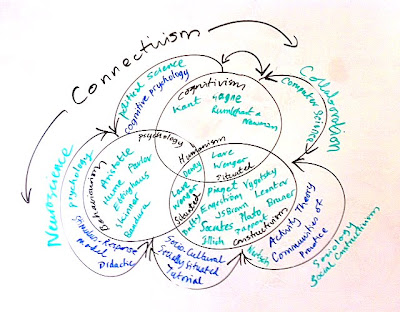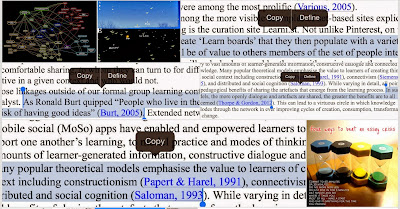
Connectedness, Comments, Curation and Collaboration are interrelated: you get 'connectedness', a George Siemens coined term, as a result of curation (putting content online) which garners comments and thus creates collaboration. Comments bring like minds together and the learning experience is enhanced as a result.
Prof Grainné Conole would be in any 'who's who of e-learning' along with a couple of dozen others. Follow her blog, read her many books and papers. I can't think that there is an MAODE module where she does not have an influence.
I've added cognitive overload as a warning really; some modules and e-learning tries to hard. Less is best. I love Rosetta Stone as a language learning platform as it keeps it simple - like playing with coloured bricks, whereas some modules I have done become unduly complex, with too many 'optional' activities and extra reading which simply adds to the complexity. Our educators are there to make choices for us.
Csicksentmihalyi isn't taught in the MAODE modules, though he ought to be. I came across him in an MBA module on creativity, innovation and change. Csicksentmihalyi coined the phrase 'in the flow' and neatly explains that balance between boredom and stress that is cured by further learning and training so that we are challenged and progress.
City & Guilds I've added as with their acquisition of Kineo, an e-learning agency, they have become a global learning and development provider online as well as off. The OU has baulked at being a global player, pulling out of Europe and resisting developing further afield. Other players, Phoenix comes to mind, are becoming global universities.
'Composting' is an odd one without explanation - it is my term to describe the need for space in learning, that whatever it is you learn takes time to bed down. It matters to me that students take two to three years to master their subject. The modular nature of OU courses may be convenient, and the 'end of year' or 'end of course' exam largely avoid, but I feel this is a significant loss. The final written exams, by their nature, galvanise your effort and pull your thinking together and produce a lasting effect.
Communities of Practice
Wenger (1998) identifies three essential features:
-
mutual engagement
-
a joint enterprise
-
a shared repertoire.
Engaging in practice over a period of time develops a shared repertoire of practices,
understandings, routines, actions, and artefacts (Wenger 1998).
Participation in communities of practice is not only about learning to do, but as a part of doing, it is about learning to be (Lave and Wenger 1991)
Firstly, it shifts the focus from teaching to learning and the practices the learner engages in (Adler 1998).
Secondly, it recharacterises the role of the teacher as not primarily being a holder of knowledge but an expert in the practices of a subject based community. The teacher exemplifies for the learner how to legitimately participate in these practices.
Thirdly, as a situated theory of learning it helps to explains the issue of a lack of ‘transfer’ of knowledge from school to non-school contexts (see Evans 2000; Lave 1988; Lerman 1999, for a discussion of this issue).
Fourthly, it recognises the intimate connection between the ‘subject’ practices and the pedagogical practices and therefore helps us to understand why different pedagogies not only influence the amount that is learned but also what is learned. The acquisition (Lave 1988) or representational model (Seely Brown and Duguid 1989) of learning in school contexts distinguishes between what the students are to learn or to ‘acquire’, and the means by which this learning occurs. A division is made between subject and pedagogy.
Fifthly, it highlights the extent to which educators are not imparting knowledge nor even only helping their students to engage in particular social practices but rather to become particular types of human beings. Thus it opens avenues of inquiry to understand learners' patterns of identification and non-identification with schools mathematics (see for example, Boaler 2000)
The community of practice model, based on the metaphor or actuality of apprenticeship learning identifies three basic positions that participants take up.
These can be referred to in the following way:
REFERENCE
Adler, J. (1998) "Lights and limits: Recontextualising Lave and Wenger to theorise knowledge ofteaching and of learning school mathematics." In Situated Cognition and the Learning of Mathematics, ed. Anne Watson, 161-177. Oxford: Centre for Mathematics Education, University of Oxford Department of Educational Studies.
Boaler, J. (2000) "Mathematics from another world: Traditional communities and the alienation of learners." Journal of Mathematical Behaviour 18, no. 3: 379-397.
Boylan, M (2004) Questioning (in) school mathematics: Lifeworlds and ecologies of practice PhD Thesis. Sheffield Hallam University
Herting, K (2006) Balancing on a thin line - Thoughts from a study of Swedish voluntary leaders in children’s football. AARE’s 36th Annual International Education Research Conference Adelaide Australia November 27 -30 2006
Lave, J, and Wenger.E (1991) Situated Learning: Legitimate Peripheral Participation. Cambridge: Cambridge University Press.
Lemke, J. (1997) "Cognition, context, and learning: A social semiotic perspective." In Situated Cognition: Social, Semiotic, and Psychological Perspectives, ed. David Kirshner and JamesWhitson, 37-56. Mahwah, NJ: Lawrence Erlbaum Associates.
Lerman, S. (1998) "Learning as social practice: An appreciative critique." In Situated
Cognition and the Learning of Mathematics, ed. Anne Watson, 33-42. Oxford: Centre for
Mathematics Education, University of Oxford Department of Educational Studies.
Seely Brown, J, and P. Duguid. (1991) Organisational learning and communities of practice: Toward a unified view of working, learning and innovation. Accessed November 2000. Available from http://www.parc.xerox.com/ops/members/brown/papers/orglearning.htm.
Wenger, E. (1998) Communities of Practice: Learning, Meaning and Identity. Cambridge: Cambridge University Press.
Cox, R. (2006) Vicarious Learning and Case-based Teaching of Clinical Reasoning Skills (2004–2006) [online], http://www.esrcsocietytoday.ac.uk/ esrcinfocentre/ viewawardpage.aspx?awardnumber=RES-139-25-0127 [(last accessed 10 March 2011).
Conole, G. (2011) ‘Stepping over the edge: the implications of new technologies for education’ in Lee, M.J.W. and McLoughlin, C. (eds) Web 2.0-based E-learning: Applying Social Informatics for Tertiary Teaching, Hershey
Conole, G. (2004). E-learning: the hype and the reality. Journal of Interactive Media in Education, 12
Csikszentmihalyi, Mihaly (1975). Beyond Boredom and Anxiety: Experiencing Flow in Work and Play, San Francisco: Jossey-Bass. ISBN 0-87589-261-2
Despite the rhetoric of the content industry, the most valuable contribution to our economy comes from connectivity, not content’. Lawrence Lessig (2008:89) CF Andrew Odlyzko ‘Content is not King’.
Calvani, A. (2009). Connectivism: new paradigm or fascinating pot-pourri?. Journal of E-learning and Knowledge Society, 4(1).
Kop, R., & Hill, A. (2008). Connectivism: Learning theory of the future or vestige of the past?. The International Review of Research in Open and Distance Learning,9(3).
Connectivism: Its place in theory-informed research and innovation in technology-enabled learning
de Waard, I. (2011). Explore a new learning frontier: MOOCs. Retrieved from Learning Solutions Magazine website: http://bit. ly/mSi4q
Bruner, J. (1986). Actual Minds, Possible Worlds. Cambridge, MA: Harvard University Press.
Driscoll, M. P. (2000). Psychology of learning for instruction. 2nd ed. Needham Heights, MA: Allyn & Bacon.
Cobb, P. (1994). Where is the Mind? Constructivist and sociocultural perspectives on mathematic development. Educational Researcher, 23 (7), pp. 13-20
Fosnot, C. T. (1996). (Ed.) Constructivism: Theory, perspectives, and practice. New York, NY: Teachers College Press.
Jonassen, D. H. (1992). Evaluating constructivist learning. In T. M. Duffy, & D. H. Jonassen (eds), Constructivism and the technology of instruction: A conversation. Hillsdale, NJ: Lawrence Erlbaum Association.
Piaget, J. (1985). The equilibration of cognitive structures. Chicago, IL: University of Chicago Press.
Smith, P. L., & Ragan, T. J. (1999). Instructional Design. 2nd ed. New York, NY: John Wiley & Sons, Inc.
Von Glaserfeld (1992). Constructivism reconstruction: A reply to Suchting. Science and Education, 1, 379-384.
Vyogtsky, L. S. (1979). Consciousness as a problem in the psychology of behavior.Soviet Psychology, 17 (4), 3-35. (Original work published in 19-24).
Vygotsky, L. S. (1978). Mind in society: The development of higher psychology process. Cambridge, MA: Harvard University Press. (Original published in 1930).
Wertsch, J. V. (1992). L. S. Vygotsky and contemporary developmental psychology. Developmental Psychology, 28 *4), 548-557. Vygotsky, L. (1986). Thought and language. Cambridge, MA: MIT Press. (Original work published 1962).








